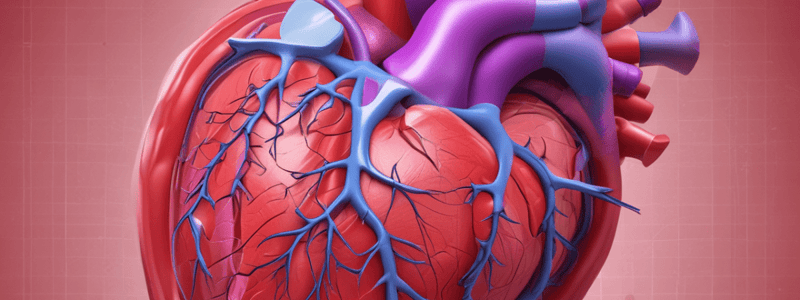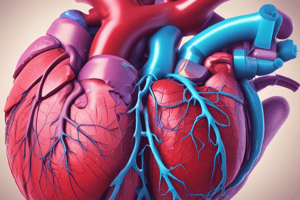Podcast
Questions and Answers
What is the most common congenital heart defect?
What is the most common congenital heart defect?
- Pulmonary valve regurgitation
- Aortic valve stenosis
- Mitral valve prolapse
- Ventricular Septal Defect (VSD) (correct)
What is the effect of a large ventricular septal defect on the left ventricle?
What is the effect of a large ventricular septal defect on the left ventricle?
- It increases the pressure in the left ventricle.
- It has no effect on the left ventricle.
- It reduces the stroke volume and cardiac output of the left ventricle. (correct)
- It increases the blood flow to the left ventricle.
What is the effect of a ventricular septal defect on the pulmonary circulation?
What is the effect of a ventricular septal defect on the pulmonary circulation?
- It reduces the blood flow to the pulmonary circulation.
- It has no effect on the pulmonary circulation.
- It increases the blood flow to the pulmonary circulation and can lead to pulmonary hypertension. (correct)
- It reverses the shunt and causes cyanosis.
What is the most common type of valvular defect?
What is the most common type of valvular defect?
What is the effect of valvular defects on the heart's efficiency?
What is the effect of valvular defects on the heart's efficiency?
What is the main cause of mitral valve prolapse?
What is the main cause of mitral valve prolapse?
What is the primary risk associated with mitral valve prolapse?
What is the primary risk associated with mitral valve prolapse?
Which of the following is a common symptom of valvular defects?
Which of the following is a common symptom of valvular defects?
What is the primary treatment for a ventricular septal defect?
What is the primary treatment for a ventricular septal defect?
What is the main consequence of a right-to-left shunt in a ventricular septal defect?
What is the main consequence of a right-to-left shunt in a ventricular septal defect?
Which of the following statements about aortic valve stenosis is incorrect?
Which of the following statements about aortic valve stenosis is incorrect?
In Tetralogy of Fallot, which of the following is NOT one of the four defects?
In Tetralogy of Fallot, which of the following is NOT one of the four defects?
In Tetralogy of Fallot, the right-to-left shunt of blood through the VSD is primarily caused by:
In Tetralogy of Fallot, the right-to-left shunt of blood through the VSD is primarily caused by:
Which of the following statements about hypertension (high blood pressure) is correct?
Which of the following statements about hypertension (high blood pressure) is correct?
Which of the following is NOT a typical treatment for hypertension?
Which of the following is NOT a typical treatment for hypertension?
In peripheral vascular disease and atherosclerosis, which of the following is NOT a typical sign or symptom?
In peripheral vascular disease and atherosclerosis, which of the following is NOT a typical sign or symptom?
In Tetralogy of Fallot, which of the following statements is correct regarding the flow of blood?
In Tetralogy of Fallot, which of the following statements is correct regarding the flow of blood?
Which of the following statements about the treatment of aortic valve stenosis is correct?
Which of the following statements about the treatment of aortic valve stenosis is correct?
Which of the following statements about hypertension (high blood pressure) is incorrect?
Which of the following statements about hypertension (high blood pressure) is incorrect?
In Tetralogy of Fallot, which of the following surgical repairs is NOT typically performed?
In Tetralogy of Fallot, which of the following surgical repairs is NOT typically performed?
What is a common sign of venous disorders mentioned in the text?
What is a common sign of venous disorders mentioned in the text?
What is a potential cause of aortic aneurysms as described in the text?
What is a potential cause of aortic aneurysms as described in the text?
Which diagnostic test is used for venous disorders according to the text?
Which diagnostic test is used for venous disorders according to the text?
What may occur due to a defect in the medial layer of an artery as per the text?
What may occur due to a defect in the medial layer of an artery as per the text?
How are gangrenous ulcers treated according to the text?
How are gangrenous ulcers treated according to the text?
What symptom indicates weakened arterial walls in the context of aortic aneurysms?
What symptom indicates weakened arterial walls in the context of aortic aneurysms?
What is a common shape of aortic aneurysms based on the text?
What is a common shape of aortic aneurysms based on the text?
Which factor leads to general hypoxia in shock conditions according to the text?
Which factor leads to general hypoxia in shock conditions according to the text?
"Shock or hypotension results from a decrease circulating blood volume," according to the text, what is the condition resulting from decreased circulating blood volume?
"Shock or hypotension results from a decrease circulating blood volume," according to the text, what is the condition resulting from decreased circulating blood volume?
Flashcards are hidden until you start studying
Study Notes
Heart Valve Disorders
- Aortic stenosis occurs when the opening of the aortic valve is narrow, causing the heart to contract with more force to push blood through, leading to hypertrophy.
- Treatment involves surgical replacement of the valve with mechanical, animal, or tissue-engineered valves, which need to be replaced every 10-12 years.
- Patients must take Warfarin or Coumadin to avoid thrombus formation.
Tetralogy of Fallot
- Tetralogy of Fallot is the most common cyanotic congenital heart condition, characterized by four defects: pulmonary valve stenosis, VSD, dextraposition of the aorta, and right ventricular hypertrophy.
- These defects alter pressures within the heart and reduce blood flow, leading to a right-to-left shunt of blood through the VSD.
- Surgery is the only option and involves closing the VSD, repairing and/or replacing the pulmonary valve, and widening the pulmonary arteries to improve flow.
Vascular Disorders: Hypertension
- Hypertension, or high blood pressure, is very common, affecting one in three adults, with about one-third being undiagnosed.
- Men are more commonly affected than women until age 55, after which the prevalence in women increases.
- African Americans have a higher prevalence of hypertension, earlier onset, and a higher average blood pressure.
- Hypertension is often called the "silent killer" due to its insidious onset and mild signs.
- There are three categories: primary or essential hypertension, secondary hypertension, and malignant or resistant hypertension.
- Treatment involves lifestyle changes, low-salt diet, reducing body weight, less stress, and exercise, followed by mild diuretics, ACE inhibitors, and other medications as necessary.
Peripheral Vascular Disease and Atherosclerosis
- Peripheral vascular disease is any abnormality in the arteries or veins outside the heart.
- Signs and symptoms include increasing fatigue and weakness in the legs, intermittent claudication or leg pain due to exercise.
- Treatment involves medication, surgery, and lifestyle changes, such as exercising more, losing weight, and elevating legs when sitting.
Ventricular Septal Defect (VSD)
- VSD is the most common congenital heart defect, characterized by a hole in the interventricular septum.
- Small defects may not affect cardiac function significantly but increase the risk of endocarditis.
- Large openings permit a left-to-right shunt of blood, reducing stroke volume and cardiac output, and can lead to pulmonary hypertension.
- Treatment involves medication and surgery.
Valvular Defects
- Valvular defects most commonly affect the aortic and pulmonary valves.
- Defects reduce the efficiency of the heart "pump" and reduce stroke volume.
- Treatment involves medication and surgery to repair or replace the defective valve.
Aortic Aneurysms
- Aortic aneurysms occur when there is a weakening of the artery wall, most commonly in the thoracic or abdominal aorta.
- Shapes include saccular and fusiform shapes, and dissecting aneurysms occur when there is a tear in the intima.
- Signs and symptoms are asymptomatic until the aneurysm is very large or ruptures, and diagnosis is made using ultrasound, CT scan, radiography, or MRI.
- Treatment involves surgery if possible, and patients should try to avoid elevations of blood pressure.
Venous Disorders: Varicose Veins
- Varicose veins are irregular, dilated, and tortuous superficial or deep veins, most commonly in the legs.
- Weakness in vein walls and standing for long periods increase pressure in veins, leading to damage and backflow of blood.
- Treatment involves support hose, elevating feet when resting or sitting, and sclerosing agents or surgical stripping.
Shock
- Shock results from a decrease in circulating blood volume, leading to decreased tissue perfusion and general hypoxia.
- Types of shock include hypovolemic, cardiogenic, obstructive, and distributive shock.
- Complications include renal failure, acute respiratory distress syndrome, hepatic failure, and death.
Studying That Suits You
Use AI to generate personalized quizzes and flashcards to suit your learning preferences.




